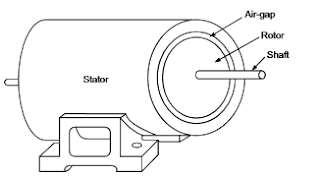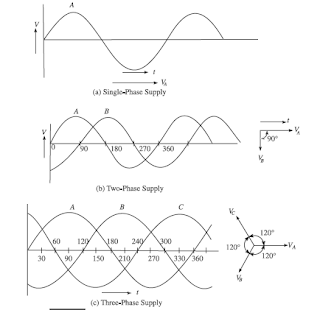BASIC PRINCIPLE, TYPES AND CONSTRUCTIONAL FEATURES OF ELECTRIC
MACHINES
There are three basic rotating electric machine types, namely
1. the dc machine,
2. the polyphase synchronous machine (ac),
3. the polyphase induction machine (ac).

|
|
Three materials are mainly used in machine manufacture; steel to conduct
magnetic flux, copper (or aluminum) to conduct electric current and insulation
to insulate the voltage induced in conductors confining currents to them. All
electric machines comprise of two parts: the cylindrical rotating member
called the rotor and the annular stationary member called the stator with the
intervening air-gap as illustrated The rotor has an axial shaft which is
carried on bearings at each end located in end covers bolted to the stator.
The shaft extends out of the end cover usually at one end and is coupled to
either the prime mover or the load. The stator and rotor are both made of
magnetic material (steel) which conducts the magnetic flux upon which depends
the process of energy conversion. In both dc and synchronous machines, the
main field is created by field poles excited with direct current. The winding on
the field poles is called the field winding. The relative motion of the field
past a second winding located in the other member induces emf in it. The
winding interchanges current with the external electric system depending upon
the circuit conditions. It is this winding, called the armature winding, which
handles the load power of the machine, while the field winding consumes a small
percentage (0.5% to 2%) of the rated load power. The load dependent armature
current is known as load current.

In a dc machine the field poles are on the stator while the rotor is the
armature as shown in the crosssectional view of Fig. 1.5. The field poles are
symmetrical and are even in number, alternately north and south. As the
armature rotates, alternating emf and current induced in the armature winding
are rectified to dc form by a rotating mechanical switch called the commutator,
which is tapped by means of stationary carbon brushes. The commutator is
cylindrical in shape and comprises severel wedge-shaped copper segments
representation of a transformer and p shows a simple electric power generation
transmission and reception system. A practical electric power system is an
integrated one, far more complex than the simple diagrammatic
representation and is in the form of an interconnected network for
reasons of economy, operational efficiency and reliability. Because the
principle of rotating ac machines is akin to that of a transformer, these two
are always studied together in a book. Further, since the transformer analogy
can be extended to both the ac machine types, the transformer study usually
precedes the machine study.
Stator
Air-gap
Rotor
Shaft
bound together while they are insulated from each other. The armature is made
of laminated steel with slots cut out on the periphery to accommodate the
insulated armature winding. The ends of each armature coil are connected to
the commutator segments to form a closed winding. The armature when carrying
current produces stationary poles (same as number of field poles) which
interact with the field poles to produce the electromagnetic torque.
In a synchronous machine the field poles could be either on the stator or
rotor, but in all practical machines the rotor carries the field poles as
shown in the cross-sectional view .The field poles are excited by
direct current. The stator forms the armature carrying a 3-phase winding wound
for the same number of poles as the rotor. All the three phases have identical
windings with the same angular displacement between any pair of phases. When
the rotor rotates, it produces alternating emf in each phase forming a
balanced set with frequency given by
f = nP 120 (1.1)
where f = frequency in Hz
n = rotor speed in rpm
P = number of field poles
For a given number of poles, there is a fixed correspondence between the
rotor speed and the stator frequency; the rotor speed is therefore called the
synchronous speed. When balanced 3-phase currents are allowed to flow in the
armature winding, these produce a synchronously rotating field, stationary
with respect to the rotor field as a result of which the machine produces
torque of electromagnetic origin. The synchronous motor is, however, non self
starting. In both dc and synchronous machines the power handling capacity is
determined by the voltage and current of the armature winding, while the field
is excited from low power dc. Thus these machine types are doubly excited.
Quite different from these, an induction machine is singly excited from
3-phase mains on the stator side. The stator winding must therefore carry both
load current and field-producing excitation current. The stator winding is
3-phase, similar to the armature winding of a synchronous machine. When
excited it produces a synchronously rotating field.
Two types of rotor constructions are employed which distinguish the type of
induction motor.
1. Squirrel-cage rotor :-
Here the rotor has copper (or aluminum) bars embedded in slots which are
short-circuited at each end . It is a rugged economical construction but
develops low starting torque.
2. Slip-ring (or wound-rotor) rotor
:-The rotor has a proper 3-phase winding with three leads brought out through
slip-rings and brushes .These leads are normally short-circuited when the
motor is running. Resistances are introduced in the rotor circuit via the
slip-rings at the time of starting to improve the starting torque.

















